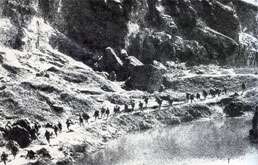Battle of Taiyuan
The Japanese offensive called 太原作戦 or the Battle of Taiyuan (Chinese: 太原會戰; pinyin: Tàiyuán Huìzhàn; Wade–Giles: T'ai-yüan Hui-tsan) was a major battle fought in 1937 between China and Japan named for Taiyuan (the capital of Shanxi province), which lay in the 2nd Military Region. The battle concluded in loss for the NRA, including part of Suiyuan, most of Shanxi and their most modern arsenal at Taiyuan and effectively ended large-scale organized resistance in the North China area.
Japanese forces included the Japanese Northern China Area Army under Hisaichi Terauchi, elements of the Kwantung Army, and elements of the Inner Mongolian Army led by Demchugdongrub. Chinese forces were commanded by Yan Xishan (warlord of Shanxi), Wei Lihuang (14th Army Group), and Fu Zuoyi (7th Army Group), as well as Zhu De who led the Eighth Route Army of the Chinese Communist Party (under the Second United Front alliance).
Occupation of the territories gave the Japanese access to coal from Datong in northern Shanxi, but also exposed them to attacks by the guerrilla forces of the Nationalist army including the Eighth Route Army, tying down many Japanese troops which could have been diverted to other campaigns.
Chronology
In September 1937, Hideki Tojo sent the Japanese army stationed in Chahar to invade Shanxi in order to exploit its resources. The city of Datong fell, and the NRA was forced to go on the defensive, and concentrated their troops along the Great Wall in battles at places like Pingxingguan and to the east at Niangziguan.
Yan Xishan also sent troops to reinforce Shijiazhuang, but that caused a lack of personnel to defend the North China area, allowing the Japanese army to break through in the north forcing the Chinese to fall back to a new line at Xinkou. Fighting continued in October in the Battle of Xinkou until the Japanese outflanked Niangziguan in late October, compromising the Chinese defense resulting in the fall of Taiyuan.
Gallery
 Soldiers of the Eighth Route Army display Japanese flags taken as prizes of war.
Soldiers of the Eighth Route Army display Japanese flags taken as prizes of war. (October 1, 1937) Chinese soldiers and civilians celebrate a local victory.
(October 1, 1937) Chinese soldiers and civilians celebrate a local victory. Chinese troops marching to defend Xinkou mountain passes.
Chinese troops marching to defend Xinkou mountain passes.
Sources
- Hsu Long-hsuen and Chang Ming-kai, History of The Sino-Japanese War (1937-1945) 2nd Ed., 1971. Translated by Wen Ha-hsiung, Chung Wu Publishing; 33, 140th Lane, Tung-hwa Street, Taipei, Taiwan Republic of China. Pg. 195–200, Map 6
- 中国抗日战争正面战场作战记 China's Anti-Japanese War Combat Operations
- Author : Guo Rugui, editor-in-chief Huang Yuzhang
- Press : Jiangsu People's Publishing House
- Date published : 2005-7-1
- ISBN 7-214-03034-9
- Online in Chinese
- 第四部分:华北作战天镇 阳高战斗与大同失陷 1-3 Tianzhen Yanggaozhan fight and Datong falls to the enemy
- 第四部分:华北作战 第二战区的决战计划 Second war zone decisive battle plan
- 第四部分:华北作战 平型关大捷 Pingxingguan victory
- 第四部分:华北作战 东跑池 鹞子涧战斗 Dongpaochi Yaozijian Battle
- 第四部分:华北作战 日军突入繁峙内长城防线弃守 Japanese Army penetrates numerous points in the Great Wall defense line its defence abandoned
- 第四部分:华北作战 平型关作战简析 Pingxingguan battles simple analysis.
- 第四部分:华北作战 会战前的一般形势太原会战 The front general situation in the Taiyuan decisive battle.
- 第四部分:华北作战 忻口作战 Xinkow Battle
- 第四部分:华北作战 正太路沿线作战 The best path to take in battles
- 第四部分:华北作战 太原陷落 Taiyuan falls
- 第四部分:华北作战 日军进攻绥远及归绥 包头失陷 The Japanese forces attack Suiyuan to subdue it, Baotou falls to the enemy